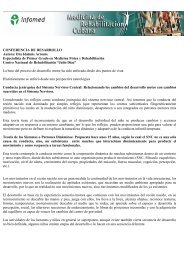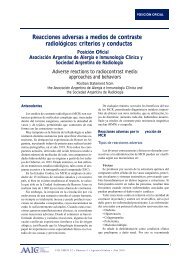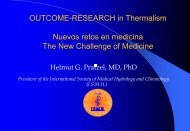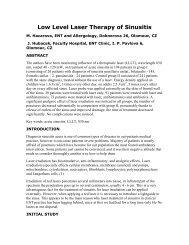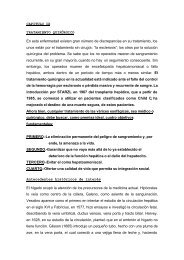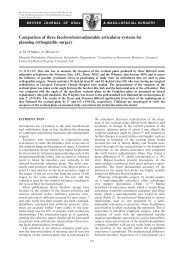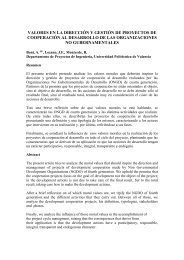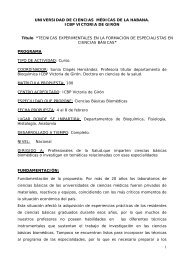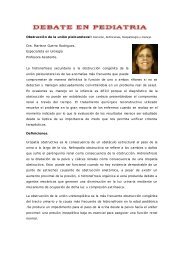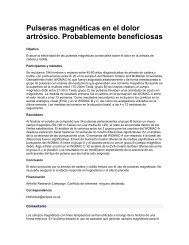Los síndromes neurológicos constituyen un grupo importante de
Los síndromes neurológicos constituyen un grupo importante de
Los síndromes neurológicos constituyen un grupo importante de
You also want an ePaper? Increase the reach of your titles
YUMPU automatically turns print PDFs into web optimized ePapers that Google loves.
Sindromogénesis y etiología<br />
Las lesiones anatómicas que originan el cuadro clínico son:<br />
<strong>de</strong>generación <strong>de</strong> los cordones anteriores y laterales <strong>de</strong> los segmentos<br />
dorsal y lumbar <strong>de</strong> la médula espinal. Se relacionan con<br />
la ingestión <strong>de</strong> leguminosas <strong>de</strong> la especie Lathyrus sativus y<br />
otras subespecies afines como alimento principal, en situaciones<br />
<strong>de</strong> hambre, como ocurre en Eritrea, India y Argelia. Se ha<br />
planteado que el factor tóxico <strong>de</strong> las semillas es el<br />
aminopropiononitrilo. La malnutrición también tiene <strong>un</strong> papel<br />
<strong>importante</strong>.<br />
Bibliografía<br />
Gopalan, C.: “Lathyrism syndrome.” Trans. Royal Soc. Trop. Med.<br />
Hyg., 44:333-338, 1950.<br />
Minchin, R.: “Primary lateral sclerosis of South India; lathyrism<br />
without lathyrus”. Br. Med. J., 1:253-255, 1940.<br />
SÍNDROME DE LAURENCE-MOON<br />
Sinonimia<br />
S. <strong>de</strong> <strong>de</strong>generación encéfalo-retiniana. S. adiposo hipogenital<br />
con malformaciones congénitas.<br />
Sindromografía<br />
Clínica<br />
<strong>Los</strong> síntomas más frecuentes en este síndrome son: retardo<br />
mental, retinopatía pigmentaria, hipogenitalismo (microfalia,<br />
hipospadia y ectopia testicular en la etapa prepuberal) y paraplejía<br />
espástica.<br />
Exámenes paraclínicos<br />
Electrorretinograma.<br />
Campimetría.<br />
Ultrasonido renal.<br />
Dermatoglifos.<br />
Cariotipo.<br />
Estudio neurológico.<br />
Sindromogénesis y etiología<br />
Este síndrome es <strong>de</strong> etiología genética y se trasmite por<br />
herencia autosómica recesiva. El <strong>de</strong>fecto básico no se conoce.<br />
Estudios <strong>de</strong> la hipófisis <strong>de</strong> pacientes afectados no han revelado<br />
anormalida<strong>de</strong>s morfológicas o inm<strong>un</strong>ocitoquímicas que expliquen<br />
el hipogonadismo <strong>de</strong> estos pacientes.<br />
Este síndrome es muy frecuente en la población <strong>de</strong> Kuwait.<br />
Bibliografía<br />
Farag, T. I. and A. S. Teeki: “Bar<strong>de</strong>t-Biedl and Laurence-Moon’s<br />
syndromes in a mixed arab population.” Clin. Genet., 33:78-<br />
-82, 1988.<br />
Laurence, J. Z. and R. C. Moon: “Four cases of retinitis pigmentosa<br />
ocurring in the same family, and accompanied by general<br />
imperfections of <strong>de</strong>velopment.” Opth. Rev., London, 2:32-41,<br />
1866.<br />
McLouglin, T. G. and D. R. Shanklin: “Pathology of Laurence-<br />
-Moon.” Bact., 93:65-79, 1967.<br />
SÍNDROME DE LAURENCE-MOON-BIEDL-<br />
-BARDET<br />
Durante años este síndrome se <strong>de</strong>nominó incorrectamente<br />
síndrome <strong>de</strong> Laurence-Moon-Biedl-Bar<strong>de</strong>t, actualmente son dos<br />
<strong>síndromes</strong> diferentes: S. <strong>de</strong> Bar<strong>de</strong>t-Biedl y S. <strong>de</strong> Laurence-Moon.<br />
358<br />
SÍNDROME DE LESCH-NYHAN<br />
Sinonimia<br />
S. <strong>de</strong> coreoatetosis-automutilación e hiperuricemia. S. <strong>de</strong><br />
gota juvenil con automutilaciones y coreoatetosis.<br />
Sindromografía<br />
Clínica<br />
Se inicia tempranamente por malhumor y accesos <strong>de</strong> cólera<br />
con automutilación compulsiva principalmente <strong>de</strong> los labios por<br />
mo<strong>de</strong>duras, seguida más tar<strong>de</strong> <strong>de</strong> espasticidad coreoatetosis y<br />
temblor.<br />
El aprendizaje <strong>de</strong>l lenguaje es tardío y disártrico acompañado<br />
<strong>de</strong> retraso mental mo<strong>de</strong>radamente grave. En los pacientes<br />
mayores <strong>de</strong> 10 años aparecen tofos gotosos en las orejas y<br />
pue<strong>de</strong> presentarse nefropatía gotosa.<br />
Examen físico. Mutilaciones en labios y <strong>de</strong>dos, trastornos<br />
<strong>de</strong> conducta, coreoatetosis, convulsiones, diparesia o<br />
cuadriparesia con hipertonía e hiperreflexia. Acentuado retraso<br />
mental, cociente <strong>de</strong> inteligencia entre 30 y 60, hematuria por<br />
urolitiasis que pue<strong>de</strong> conducir a la uremia.<br />
Exámenes paraclínicos<br />
Sangre. Ácido úrico elevado, 7-10 mg%. Baja actividad <strong>de</strong><br />
la enzima hipoxantina-guanina-fosforribosiltransferasa<br />
(HGFRT). Anemia megaloblástica.<br />
Biopsia renal. Se aprecian lesiones <strong>de</strong> nefropatía gotosa<br />
con <strong>de</strong>pósitos <strong>de</strong> ácido úrico en el intersticio.<br />
Sindromogénesis y etiología<br />
Hay <strong>un</strong>a hiperproducción <strong>de</strong> ácido úrico por <strong>de</strong>ficiencia <strong>de</strong><br />
hipoxantina-guanina fosforribosiltransferasa “casi completa”.<br />
Trastorno metabólico raro que se hereda con <strong>un</strong> rasgo<br />
recesivo ligado al cromosoma XY y sólo la pa<strong>de</strong>ce el varón,<br />
mientras que la hembra pue<strong>de</strong> ser portadora heterocigoto.<br />
El gen se ha localizado en Xq26-27. Estudios moleculares<br />
han evi<strong>de</strong>nciado heterogeneidad en el síndrome <strong>de</strong>bido a mutaciones<br />
p<strong>un</strong>tuales, pequeñas <strong>de</strong>lecciones <strong>de</strong>l ADN que afectan la<br />
transcripción, estabilidad o integridad <strong>de</strong>l mensaje genético para<br />
la síntesis normal <strong>de</strong> la HGFRT.<br />
Bibliografía<br />
Francke, U.; B. Bakay and W. L. Nyhan: “Detection of<br />
heterozygous carrriers of the Lesch-Nyhan syndrome by<br />
electrophoresis of hair roots lysats.” J. Pediat., 82:472, 1973.<br />
Lesch, M. and W. L. Nyhan: “A familial disor<strong>de</strong>rs of uric acid<br />
metabolism and central nervous system f<strong>un</strong>ction.” Am. J. Med.,<br />
36:561, 1964.<br />
Keliey, R. et al.: “Hipoxanthine-guanine phosphoribosyltransferase<br />
<strong>de</strong>ficiency in gout.” Ann. Intern. Med., 70:155,1969.<br />
Sinnet, D. et al.: “Lesch-Nyhan’s syndrome; molecular investigation<br />
of three french canadian families using a hypoxantineguanine<br />
phosphoribosyl transferasa cDNA probe.” Hum. Genet.,<br />
81:4-8, 1988.<br />
Wilson, J. M. et al.: “Hipoxanthine-guanine phosphoribosyltransferase<br />
<strong>de</strong>ficiency. The molecular basis of the clinical<br />
syndromes”. N. Engl. J. Med., 309:900, 1983.<br />
SÍNDROME DE LESIÓN DE LA COLUMNA<br />
CERVICAL CON CONFUSIÓN PROGRESIVA<br />
Sindromografía<br />
Clínica<br />
Se presenta en pacientes con fractura <strong>de</strong> la columna cervical<br />
y en lesiones no traumáticas <strong>de</strong> la médula espinal. Hay pérdida




